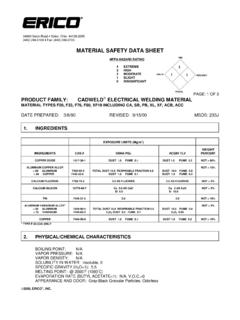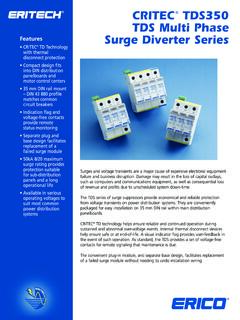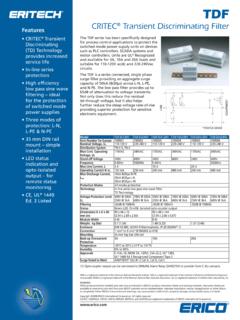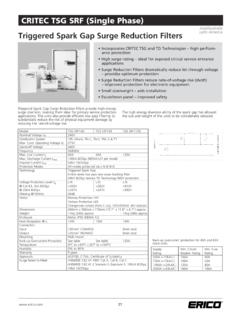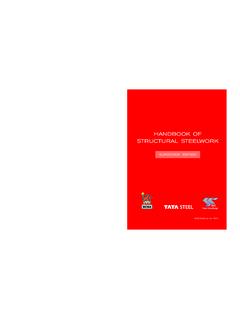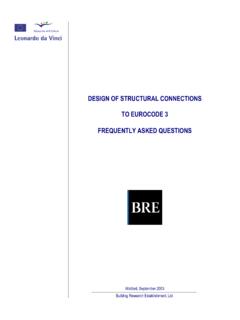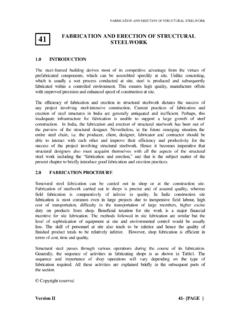Transcription of 1. Soil Resistivity Testing
1 Earthing Techniques 1. soil Resistivity THEORY OF soil MAKING A MEASUREMENT .. 4 soil Resistivity Testing PROCEDURE GUIDELINES .. (a) Test (b) Selection of Test Method Type .. (c) Traverse Locations.. (d) Spacing (e) Practical Testing 10 2. INTERPRETATION AND MODELLING OF RESULT ..11 APPARENT Resistivity CALCULATION .. 11 INTERPRETATION OF Resistivity 12 3. HOW TO DESIGN A LIGHTNING EARTH SYSTEM ..14 TYPES OF EARTH ELECTRODES .. 14 COMMON EARTHING SYSTEMS .. 14 EARTH RESISTANCE OF AN ELECTRODE - CALCULATION.
2 16 Rods Driven Vertically into the 16 Rod Electrodes in Parallel .. 16 Trench Electrodes - Horizontal Electrodes buried under the 17 Radial Conductors .. 18 Ground-grid Mesh 19 RECOMMENDED MATERIAL APPLICATIONS .. 19 4. Testing AN EARTHING SYSTEM ..21 EARTH RESISTANCE OF AN ELECTRODE - MEASUREMENT .. 21 Fall of Potential Method .. 22 The 62% Method .. 24 Other Test Methods .. 24 (a) The Slope Method .. 24 (b) The Star-Delta 24 (c) The Four Potential 25 5. THE SIGNIFICANCE OF 26 27 Earthing Fundamentals Lightning & Surge Technologies Impulse Testing And The Transient Assessing the transient performance of an earthing The Impulse Definition of the Impulse Interpreting Impulse Impedance Variations in the Impulse Impedance within an earthing Comparing Impulse Impedance and DC Resistance Selective Earth Testing in Interconnected Earth Systems.
3 31 6. PRACTICAL EARTH SYSTEM APPLICATION Satellite Ground Marine Communications PABX lightning induced Cellular radio A mountain top site for Civil Aviation 7. IMPROVING AN EARTHING FACTORS TO EXAMPLES OF ACHIEVING SUITABLE EARTHING INSTALLATIONS USING CHEMICAL Example Example Example Example NOTES ON THE APPLICATION OF CHEMICAL 39 Measures For Reducing The Impulse WHAT TO DO IN EXTREME CASES ?..40 Page 2 of 40 Earthing Fundamentals Lightning & Surge Technologies 1. soil Resistivity Testing INTRODUCTION It is well known that the resistance of an earth electrode is heavily influenced by the Resistivity of the soil in which it is driven and as such, soil Resistivity measurements are an important parameter when designing earthing installations.
4 A knowledge of the soil Resistivity at the intended site, and how this varies with parameters such as moisture content, temperature and depth, provides a valuable insight into how the desired earth resistance value can be achieved and maintained over the life of the installation with the minimum cost and effort. One of the main objectives of earthing electrical systems is to establish a common reference potential for the power supply system, building structure, plant steelwork , electrical conduits, cable ladders & trays and the instrumentation system. To achieve this objective, a suitable low resistance connection to earth is desirable.
5 However, this is often difficult to achieve and depends on a number of factors: soil Resistivity Stratification Size and type of electrode used Depth to which the electrode is buried Moisture and chemical content of the soil Section covers the first of these points. THEORY OF soil Resistivity Resistance is that property of a conductor which opposes electric current flow when a voltage is applied across the two ends. Its unit of measure is the Ohm ( ) and the commonly used symbol is R. Resistance is the ratio of the applied voltage (V) to the resulting current flow (I) as defined by the well known linear equation from Ohm s Law: VIR= where: V Potential Difference across the conductor (Volts) I Current flowing through the conductor in (Amperes) R Resistance of the conductor in (Ohms) Good conductors are those with a low resistance.
6 Bad conductors are those with a high resistance. Very bad conductors are usually called insulators. The Resistance of a conductor depends on the atomic structure of the material or its Resistivity (measured in Ohm-m or -m), which is that property of a material that measures its ability to conduct electricity. A material with a low Resistivity will behave as a good conductor and one with a high Resistivity will behave as a bad conductor . The commonly used symbol for Resistivity is (Greek symbol rho). The resistance (R) of a conductor, can be derived from the Resistivity as: Page 3 of 40 Earthing Fundamentals Lightning & Surge Technologies RL= A here Resistivity ( -m) of the conductor material etween the opposite faces of a cube of material with a side dimension of 1 metre.
7 Consequently, is the measure of the resistance between the opposite sides of a cube of soil with a side dimension of 1 metre. T When designing an earthing system to meet safety and reliability criteria, an accurate Resistivity model of following sections outline the major practical aspects of the measurement lues in the Australian continent are widely varying depending on the type of terrain, eg, rder of m, whereas dry sand or granite in fect Resistivity may be n; layers of different types of soil (eg, loam backfill on a clay base). , after a ith content greater than 40% do not occur ture; above freezing point, the effect on earth Resistivity is practically negligible.
8 Able ducts, rail tracks, metal pipes and fences. Topography; rugged topography has a similar effect on Resistivity measurement as local surface Resistivity variation caused by weathering and moisture. w L Length of the conductor (m) A Cross sectional Area (m2) Resistivity is also sometimes referred to as Specific Resistance because, from the above formula, Resistivity ( -m) is the resistance bSoil ResistivityIn the USA, a measurement of -cm is used. (100 -cm = 1 -m) MAKING A MEASUREMENthe soil is required. Theprocedure and result interpretation.
9 PRINCIPLES soil Resistivity vasilt on a river bank may have Resistivity value in the omountainous country areas may have values higher than 10,000 m. Factors that afsummarised as:- Type of earth (eg, clay, loam, sandstone, granite). Stratificatio Moisture content; Resistivity may fall rapidly as the moisture content is increased, howevervalue of about 20% the rate of decrease is much less. soil wvery often. Tempera Chemical composition and concentration of dissolved salt. Presence of metal and concrete pipes, tanks, large slabs, c Page 4 of 40 Earthing Fundamentals Lightning & Surge Technologies Table 1-1 to Table 1-3 show how typical values alter with changes in soil , moisture and temperature.
10 Table 1-1 Resistivity values for several types of soils and water Type of soil or Water Typical Resistivity m Usual Limit m Sea water Clay Ground well & spring water Clay & sand mixtures Shale, slates, sandstone etc Peat, loam & mud Lake & brook water Sand Moraine gravel Ridge gravel Solid granite Ice 2 40 50 100 120 150 250 2000 3000 15000 25000 100000 to 10 8 to 70 10 to 150 4 to 300 10 to 100 5 to 250 100 to 400 200 to 3000 40 to 10000 3000 to 30000 10000 to 50000 10000 to 100000 Typical Resistivity m Moisture % by weight Clay mixed with sand Silica based sand 0 5 10 15 20 30 10 000 000 1 500 430 185 105 63 42 - 3 000 000 50 000 2 100 630 290 - Table 1-2 - Variations in soil Resistivity with moisture content Temp.
